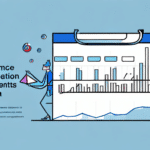Understanding Average Order Value (AOV) in E-commerce
Average Order Value (AOV) is a critical metric for e-commerce businesses, measuring the average amount a customer spends per transaction on your online store. Calculating and optimizing AOV can provide valuable insights into your business's profitability, revenue streams, and growth potential.
How to Calculate AOV
The calculation for AOV is straightforward: divide your total revenue by the number of orders. For example, if your online store generates $50,000 in sales from 500 orders in a month, your AOV would be $100.
- Formula: AOV = Total Revenue / Number of Orders
- Example: $50,000 / 500 orders = $100 AOV
It's important to consider factors such as seasonal trends and promotional activities that might temporarily influence AOV.
The Importance of Measuring AOV for E-commerce Success
Tracking AOV is essential for understanding customer purchasing behavior and the effectiveness of your pricing and marketing strategies. A higher AOV typically indicates that customers are spending more per transaction, which can lead to increased profitability without necessarily increasing customer acquisition costs.
Benefits of Monitoring AOV
- Revenue Insights: Identify trends and patterns in customer spending.
- Strategic Decision-Making: Inform pricing strategies and promotional campaigns.
- Upselling Opportunities: Pinpoint opportunities to encourage higher-value purchases.
Impact on Profitability
By increasing AOV, businesses can boost their revenue without acquiring additional customers. For instance, implementing upselling or cross-selling techniques can effectively raise the AOV, enhancing overall profitability.
Strategies to Increase Your AOV
Optimizing AOV involves several strategies aimed at encouraging customers to spend more during each transaction. Here are some effective methods:
Product Bundling and Packages
Offer bundled products at a discounted rate to encourage customers to purchase multiple items simultaneously. This not only increases the AOV but also enhances the perceived value for the customer.
Upselling and Cross-selling
Suggest higher-end products or complementary items during the shopping process. Personalized recommendations based on customer behavior can significantly boost AOV.
Minimum Purchase for Free Shipping
Set a minimum order value that qualifies for free shipping. This incentivizes customers to add more items to their cart to reach the free shipping threshold, thereby increasing AOV.
Loyalty Programs and Rewards
Implement loyalty programs that reward customers for higher spending. Offering points or discounts for larger purchases encourages repeat business and higher AOV.
Common Challenges in Measuring and Optimizing AOV
While AOV is a valuable metric, several challenges can arise in its accurate measurement and optimization:
Data Accuracy and Tracking
Ensuring accurate tracking of all transactions, including discounts and returns, is crucial for precise AOV calculation. Utilizing reliable analytics tools can help maintain data integrity.
Impact of Returns and Refunds
Returns and refunds can skew AOV calculations. It's important to account for these factors by either excluding them from the AOV calculation or analyzing their impact separately.
Seasonal Variations
Seasonal trends and promotional periods can cause fluctuations in AOV. Understanding these patterns allows for more accurate analysis and strategic planning.
Tools and Techniques for Tracking AOV
Effective tracking of AOV requires the use of robust tools and techniques. Here are some recommended options:
Google Analytics
Google Analytics offers comprehensive e-commerce tracking features, including AOV metrics. By setting up e-commerce tracking, businesses can gain insights into customer behavior and purchasing patterns.
Learn more about Google Analytics
E-commerce Platforms
Platforms like Shopify and Magento offer built-in analytics dashboards that provide real-time AOV data and other vital metrics.
Customer Segmentation
Segmenting customers based on purchasing behavior allows for more targeted marketing strategies. Tools like Segment can help in creating detailed customer segments for better AOV analysis.
Benchmarking AOV Against Industry Standards
Comparing your AOV with industry benchmarks helps in assessing your business performance:
Understanding Industry Standards
Industry benchmarks vary across different sectors. For instance, the average AOV in the fashion industry might differ significantly from that in electronics. It's essential to refer to credible sources for accurate benchmarking data.
According to Statista, the global average AOV has been steadily increasing, reflecting growing consumer spending online.
Identifying Growth Opportunities
If your AOV is below the industry average, it indicates potential areas for improvement in your pricing strategy, product offerings, or marketing tactics. Conversely, exceeding the average suggests effective strategies that can be further leveraged.
Case Studies: Leveraging AOV for E-commerce Growth
Examining real-world examples can provide actionable insights into optimizing AOV:
Amazon's Recommendation Engine
Amazon utilizes sophisticated algorithms to recommend related products to customers during the shopping process, effectively increasing AOV by suggesting additional purchases.
Sephora's Loyalty Program
Sephora's Beauty Insider program rewards customers for higher spending with exclusive discounts and products, encouraging increased AOV and fostering customer loyalty.
The Future of AOV Measurement in E-commerce
As e-commerce evolves, so does the approach to measuring and optimizing AOV:
Integration of AI and Machine Learning
Artificial Intelligence (AI) and Machine Learning (ML) are increasingly being integrated into e-commerce platforms to provide more personalized shopping experiences. These technologies can analyze vast amounts of data to predict customer behavior and suggest optimal product bundles, thereby increasing AOV.
Enhanced Data Privacy Measures
With growing concerns over data privacy, businesses must ensure that their methods for tracking and analyzing AOV comply with regulations such as the General Data Protection Regulation (GDPR) and California Consumer Privacy Act (CCPA).
Conclusion: Maximizing Your Average Order Value
Average Order Value is a vital metric that offers deep insights into customer behavior and business performance. By accurately measuring AOV and implementing strategic optimization techniques, e-commerce businesses can enhance their revenue, profitability, and overall growth. Regular analysis and adaptation to industry trends will ensure that your strategies remain effective in a dynamic market landscape.




















